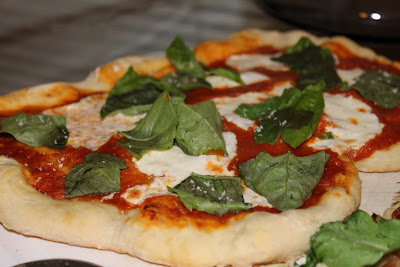 |
| Margarita |
 |
Speck, Artichoke, Arugula and Burrata
|
Homemade pizza dough from Cooks Illustrated recipe:
Pizza Dough from Cooks Illustrated
published May 1, 1995
This dough can be used for any size pizza with thick or thin crust; simply adjust the cooking time to fit the pizza. Make sure you heat the oven to 500 degrees for thirty minutes before you start cooking. Your tiles or stone need at least that long to heat up; if they’re not properly heated, your pizza crust will be thin, blond, and limp. Once the dough for the crust has been topped, use a quick jerking action to slide it off the peel and onto the hot tiles or stone; make sure that the pizza lands far enough back so that its front edge does not hang off. For a cornmeal-flavored dough, substitute three-quarters cup of cornmeal for three-quarters cup of the bread flour. Editor's Note: This recipe was updated in 1997, when we found that adding more water resulted in a tastier pizza. This recipe contains a total of 1 3/4 cups water, while the original that appeared in the magazine in 1995 contains 1 1/2 cups.
published May 1, 1995
This dough can be used for any size pizza with thick or thin crust; simply adjust the cooking time to fit the pizza. Make sure you heat the oven to 500 degrees for thirty minutes before you start cooking. Your tiles or stone need at least that long to heat up; if they’re not properly heated, your pizza crust will be thin, blond, and limp. Once the dough for the crust has been topped, use a quick jerking action to slide it off the peel and onto the hot tiles or stone; make sure that the pizza lands far enough back so that its front edge does not hang off. For a cornmeal-flavored dough, substitute three-quarters cup of cornmeal for three-quarters cup of the bread flour. Editor's Note: This recipe was updated in 1997, when we found that adding more water resulted in a tastier pizza. This recipe contains a total of 1 3/4 cups water, while the original that appeared in the magazine in 1995 contains 1 1/2 cups.
INGREDIENTS
- 1 3/4 cups water divided, 1/2 cup warm, remaining at tap temperature
- 2 1/4 teaspoons dry active yeast (1 envelope)
- 2 tablespoons olive oil, plus extra for brushing dough
- 4 cups bread flour
- 1 1/2 teaspoons table salt
- Vegetable oil (or cooking spray) for oiling bowl
- Semolina for dusting peel
INSTRUCTIONS
- Measure 1/4 cup of warm water into 2-cup measuring cup. Sprinkle in yeast; let stand until yeast dissolves and swells, about 5 minutes. Add remaining 1/4 cup warm water plus remaining 1 1/4 cups tap water and olive oil. Meanwhile, pulse flour and salt in workbowl of large food processor fitted with steel blade to combine. Add liquid ingredients (holding back a tablespoon or so) to flour and pulse together. If dough does not readily form into ball, stop machine, add remaining liquid, and continue to pulse until ball forms. Process until dough is smooth and satiny, about 30 seconds longer.
- Turn dough onto lightly floured work surface; knead by hand with a few strokes to form smooth, round ball. Put dough into medium-large, oiled bowl, and cover with damp cloth. Let rise until doubled in size, about 2 hours.
- Turn dough out onto lightly floured work surface and use chef’s knife or dough scraper to halve, quarter, or cut dough into eighths, depending on number and size of pizzas desired. Form each piece into ball and cover with damp cloth. Working with one piece of dough at a time, shape as shown in illustrations below. Transfer to pizza peel that has been lightly coated with semolina, brush dough very lightly with olive oil before topping and cooking.
- Use the following guide to determine cooking time for pizza crust with topping but without cheese. All pizzas need to be cooked an additional two or three minutes after adding cheese, or until cheese is completely melted.

No comments:
Post a Comment